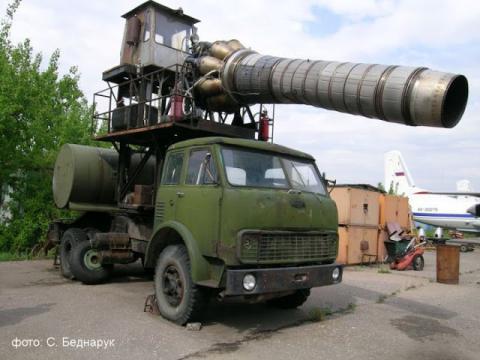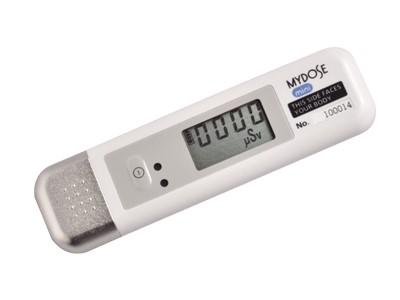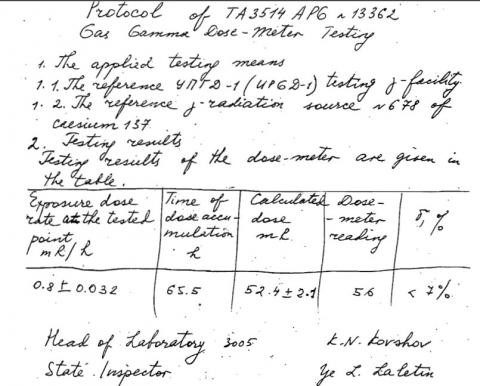Lab-to-Lab: US-Russian Lab-to-Lab Collaboration Story [Archived]
- Brodie Anderson
- Doctor Thomsen
- Patricia Newman
- Bits of Humor
- Not By Bread Alone
- The Curious Incident
- 2nd Chances
- Walt Atchison
* An unapologetic allusion to the prize-winning book, The Curious Incident of the Dog in the Night-Time, by Mark Haddon – and, of course, to Sherlock Holmes.
Paul C. White
Los Alamos National Laboratory, Ret.
It was a brisk and snowy January day as we Americans arrived in Sarov, Russia, dragging our luggage to an ‘arrivals’ building for ‘inspection.’ Security personnel were generally looking for electronic equipment, and we dutifully identified everything from radios to watches to cameras. Then we repacked our bags and prepared to follow our hosts to our accommodations for the coming week.
Suddenly a colleague tugged on my arm and, in a low voice, told me the pocket dosimeter he was carrying was reading 756 millirem (mrem). We had only been in Sarov an hour, and this reading was way, way above a normal background dose rate of about 1 mrem per hour. Uh-oh! What did this mean, and what should we do?
Arrival
We were 23 scientists from the three U.S. nuclear weapons laboratories, and we were the largest delegation of foreign researchers and engineers ever to visit Arzamas-16 (or RFNC-VNIIEF, as it is now known), the Russian equivalent of Los Alamos National Laboratory (LANL). The other two U.S. labs were Livermore (LLNL) and Sandia (SNL), and we were in Sarov for an important and very symbolic unclassified symposium on nuclear weapons safety and security.

Jet engine mounted on a truck.
The U.S. team had assembled in Moscow during the days before, and early on this Wednesday morning, 26 January 1994, our hosts had arranged buses that took us from our hotel to a regional airport in the city. Snow was everywhere, blowing in the air and covering the grounds and runways of the airfield as well as every plane we could make out through the flurries. After the usual security checks and passing our luggage through x-ray screening we were driven through the drifts right to stairs of our snow-covered, two engine turboprop aircraft in Aeroflot livery. To our surprise, we were immediately ushered aboard, the doors were closed, and the snow and ice were blown off the plane with a jet engine mounted on a truck. It clearly worked, and in a few minutes we were airborne. After a noisy flight of just over an hour, the pilot made a perfect landing on the windswept, icy runway in Sarov.

Aloka digital pocket dosimeter
Some of us had been to Russia – or the Soviet Union – before, but many in our group were in-country for the first time and were a bit nervous. Because of stories about questionable radiation safety in Russia, and in an abundance of caution, some in our group carried pocket dosimeters. There were four thermoelectric dosimeters (TLDs), for which readouts could only be obtained back home, and two prompt-read-out, Aloka digital pocket dosimeters. The Aloka dosimeters were carried by one of my LANL colleagues, with one on his person that had been turned on when he left the Moscow hotel. The other was in his luggage and had not been turned on. During the arrival inspection, our possession of these dosimeters was disclosed to the Arzamas-16 security personnel, and they were ok with them.
So, after my colleague’s hushed revelation, there we were – inside one of the famous Russian closed cities, a nuclear weapons design laboratory, for a first-of-its-kind technical symposium – and holding an instrument displaying a radiation dose equivalent to that from a typical CT-scan or from over two years of natural background radiation. This was not normal, or at all what we expected. What to do?
On the way to our lodgings, I brought the situation to the attention of the two leaders of the other U.S. laboratory groups. My colleague and I were the only members of the team with any health physics background. We and the other two leaders agreed that we really lacked sufficient information to sound any alarm – especially one that might jeopardize the symposium in the absence of further data. We concluded that we should turn on the second Aloka (prompt-read) dosimeter as soon as possible and monitor each for any further dose accumulation.
After dinner that evening, our team gathered in a small lounge area at the head of the stairs in our hotel – the largest convenient gathering place but some were still sitting on the floor. We described the dosimeter reading, and could now add that in the 12 hours since our arrival the dosimeter had only accumulated an additional 3 mrem, consistent with a natural background rate. The second dosimeter, now in operation, was similarly quiet. My colleague and I were sure that whatever had happened to cause the initial reading of 753 mrem was not continuing to cause any further significant dose. However, a few of our scientists were seriously concerned. Some wanted to abort the visit and return home. But we also feared the possibly of serious political fallout if we terminated this ground-breaking visit over an unconfirmed ‘radiation incident.’ In the end, after a rather free-ranging discussion, we agreed to stick with the plan for the symposium, to continue monitoring for any further dosage, and to keep the whole team informed. But we went to sleep still not knowing what had happened.
The next morning it was still snowing, and we enjoyed watching kids and adults alike use skis to navigate the roads and paths to school and work. This was a lay-day for us, and an opportunity to attend some of the administrative arrangements for the symposium, and for our hosts to show us a bit of the town. It was also a chance for some of our team to arrange telephone and e-mail communications with home. One of the conditions for the symposium was that our hosts provide for such communications, even if all emails and faxes were transmitted and received through them. Naturally, some of these communications involved reporting the high initial reading of the Aloka dosimeter. They were also an occasion to share that no additional dose accumulation had been observed. Yet the mystery of the initial dose remained.
Confrontation
Those local tours helped somewhat in holding jet-lag at bay, and gave us time to deal with symposium administration – interpreters, session chairs, order of presentations, etc. Then, on the first ‘official’ day, and preoccupied with our hopes for success, we blithely walked into the House of Scientists – a sprawling, Soviet-style building with large meeting hall, cloakroom, dining room, and some side meeting rooms. Having shed our coats and moving in the direction of the reception area, we were faced with a clutch of agitated Arzamas-16 officials striding towards us and announcing that, “Tsyrkov wants to talk with you.” When we tried to wait for one of our engineers who spoke fluent Russian, and who at the moment was in the midst of another conversation, we were interrupted with, “Mr. Tsyrkov will meet with you NOW!” We (the leads from the US Labs and DOE and our Russian-speaking engineer) were ushered into a cramped side room for a meeting dominated by the ranking Minatom official at the symposium. Georgi Aleksandrovich Tsyrkov was a gruff individual, leader of the Minatom 5th Main Directorate, the organization responsible for oversight of Russian nuclear weapons design – the rough analog of the National Nuclear Security Administration of USDOE. ( In later interactions, he revealed a delightful sense of humor.) The head of security for Azamas-16 was also there. Tsyrkov had a printout of an email from Sandia asking us about the radiation release from the fire in Sarov, and demanded to know what this was about. He insisted there was no radiation release, and that we – and especially the Sandia lead – must report that there was no release. We weren’t sure what to believe.
It seemed that at least two issues had become conflated. Our labs back in the US had heard reports about a fire at an Avangard plant in Sarov and that rumors of a resulting radiation release had swept through town, with anxious parents taking their children out of schools near the plant. Among other sources, the Sandia email cited a Moscow TV news story. We had not known anything about the fire, and our emails reporting the anomalously high dosimeter reading had been linked by folks at home with the radiation release rumors from Sarov. This assumed connection resulted in the urgent email request for information that prompted our audience with Tsyrkov. We had worried that telling our hosts about the dosimeter reading might provoke some sort of incident. Now the dragon’s teeth of rumor and incomplete information were threatening to spawn a very real problem.
Cooperation
Faced with a great deal of uncertainty and a very adamant Georgi Tsyrkov, the best approach was to be as open and clear as possible about what we knew and what were our concerns. We told Tsyrkov and the Arzamas-16 officials about the high reading from the dosimeter, emphasizing we had no idea just where or when the ‘dose’ might have occurred – only that it had happened sometime between our departure from our Moscow hotel and our arrival at our hotel in Sarov. Even though they knew part of this story from those lab emails, our revelation caused great consternation. There had been no radiation release in Sarov, they insisted. Nothing had happened to cause this reading. Yes, there had been a fire – as reported in the emails. But that fire had not released any radiation. Indeed, no radioactive material had ever been in the location where the fire occurred. You must report to your labs that there was no release!
We said we would be happy to tell our labs about his assurances. Could they write out what they would like us to say? They did so and provided us with an English translation of what they wanted sent right away by email. We indicated we could not send this statement all by itself, and insisted on a phone call that would enable greater clarity. Tsyrkov declared, “No phone call.” We said, “Then no email.” In the end, we did both – phone calls and email. This is what we sent in an email to our labs, word-for-word as provided to us by our hosts:
Statement received from VNIIEF leadership
There was no release in Arzamas-16. On January 26, during the repair works on ventilation pipeline in laboratory where no radioactive substances ever have been, a ventilation filter was ignited with a spark from the welding apparatus. The ignition was immediately extinguished. This has caused gossips which were refuted in radio announcement.
We understood better the reference to ‘gossips’ when an article appeared that weekend, in the Sunday edition of the Arzamas-16 City Courier. The item, entitled “What Happened at the ‘Avangard’ Plant – official explanation” is attached to this story. It also turned out that some of the ‘rumors’ had been spread through personal contacts between Arzamas-16 and Los Alamos scientists in the U.S. Phone calls and emails to prepare for a joint experiment conveyed the concerns of families in Sarov to collaborators in the U.S. The more things were opening up among our laboratories and institutes, the more channels were available for communication of both good and bad information.

Calibration result of the Aloka dosimeter.
In the spirit of sorting good information from the bad, we continued cooperating with our hosts in every way possible. We loaned one of our Aloka dosimeters to the Arzamas-16 Head of the Department of Radiation Safety for calibration. This calibration, using a Cesium-137 source, indicated the dosimeter read within 7% of the calculated dose. A translation of this calibration result is attached. While some of us had meetings in Moscow, most of our team would be going straight home after the symposium ended on Tuesday, 1 February. Those who were carrying TLDs would have those dosimeters read at their labs, and other personnel would provide bioassay samples and have whole body counts conducted. We would also have experts review scenarios that might have led to the high Aloka reading. Every possibility, finding and result would be shared with our Russian counterparts. There was still a mystery, but we would try to solve it together.
Outcomes
The dosimeter mystery persisted, but that in no way kept us from continuing with our meeting. The evening of Tuesday, 1 February, we celebrated the successful conclusion of this trailblazing symposium. Our hosts threw an unforgettable and lavish banquet, complete with entertainment and endless toasting. The following day, a bit the worse for our indulgences, we all flew back to Moscow on that noisy, but reliable twin turboprop. After a day of recovery in the capital, most left for home while the rest of us prepared reports for our labs and more meetings. Those engagements included a round of negotiations pursuant to a formal, government-to-government agreement on technical exchanges that would supplant the surety symposia. We had also scheduled a meeting at the Institute of Automatics (VNIIA) about their involvement in these exchanges.
As we prepared for the Automatics meeting, the first reports from home about the dosimeter reading began to trickle in. The cloud of mystery, together with any lingering suspicions, quickly began to dissipate. First, we learned that the initial TLD read at Los Alamos revealed its wearer had received no measurable dose. Later we found that the rest of the TLDs also indicated no measurable dose, and that personal bioassays and whole body scans similarly showed no detectable activity above background levels. The Health Physics Measurements group at Los Alamos made a calibration check of the Aloka digital dosimeter that had registered the high reading in Sarov. This calibration, like the one conducted by Arzamas-16, showed this dosimeter to be reading within 91% of calculated dose over a range of exposures. So, what in the world had produced the anomalously high Aloka dosimeter reading?
The devil, as it turns out, was in the details – or at least in the fine print. That’s where the folks back home, the Measurements experts, discovered a note in the Aloka dosimeter documentation – the instrument could malfunction if exposed to high electromagnetic fields. Really? Yes, really! And guess what had been the operational history of the culprit – the dosimeter that had exhibited the high reading? While turned on, it had been carried across the snow-covered tarmac of that regional airport in Moscow. The dosimeter had undoubtedly been exposed to electromagnetic fields from the operating radars the airfield. Since the instrument was not read until after arrival in Sarov, and since duplicating the experience was not feasible, it was not possible to be absolutely certain. It is likely, however; indeed, it is highly probably that radar disruption of the dosimeter was the sole cause of the anomalously high – and indeed faulty – reading of 756 mrem.
This likely explanation, together with the negative results from the TLD readings, the bioassays, and the whole-body scans, were given to Tsyrkov during the meetings at VNIIA on 10 February. A full written report was later provided to Minatom and to our Arzamas-16 hosts. Georgi Aleksandrovich was so pleased and relieved – one can only imagine the pressure he must have been under from ‘above’ – that he embraced me heartily, planting a very noisy kiss on my cheek.
I only wish I had a picture. It would have been a fitting symbol of an incident closed, a crisis avoided, a mystery solved. We were on the threshold of new forms of cooperation among the nuclear weapons scientists of our two countries. Yet a false radiation alarm and an innocuous fire, both fanned by rumors and fear, could have derailed it all. In the end, however, a willingness to cooperate, to share information, combined with good leadership on both sides, avoided a crisis and set an example for how our laboratories could and should work together in the future. **
**Credit for good leadership goes to the lead representatives from the US weapons laboratories and USDOE and to the Arzamas-16 hosts. However, special credit is due to David Nokes, the Sandia lead, and to Georgi Tsyrkov of Russian Minatom.
Related content: Surety Symposia
